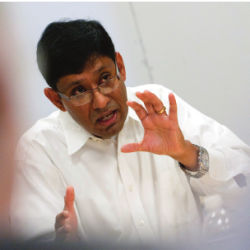
In 2007, After spending 20-plus years in academia, founding two successful companies, and being honored by some of the industry’s most prestigious technical societies, Prith Banerjee turned his considerable energies to the world of corporate research. Here, the director of Hewlett-Packard Labs talks about how to balance scientific and business goals, collaborate with university researchers, and inspire people to think big.
When you joined HP Labs, you undertook a fairly ambitious reorganization. Can you describe your new approach?
Our approach is focused on several themes. One is to work on what we call high-impact research, or "big bets." In the past, we used to have 150 smaller projects. Each was interesting, but none had the chance to move the needle for HP. Now we focus our energies on about 20 big bet projects. These projects are simultaneously trying to advance the state of the art—to do something that the world doesn’t know how to do today—and to have a significant business impact for HP.
You’ve also organized your research around eight key topics, such as analytics, immersive interaction, information management, and so on.
In the ideal world of academic purity, each researcher does whatever they want and you hope for the best. But our approach has been an approach of focus, and that’s really paid off.
Many people have begun to question the role of the corporate research lab in an era of low-cost communication and shrinking profit margins.
HP invests a lot in R&D, but much of the research is done in the various product divisions. Our role is to look beyond that and provide the company with opportunities that will be interesting in three, five, 10, 15 years. One-third of our research is devoted to fairly basic fundamental science. One-third of our research is related to a product. The third area is applied research, which is somewhere in between.
You’ve also made a big push toward open innovation with your annual Innovation Research Awards.
Working with academia is something many companies do, so that part is not new. The novelty of the HP approach is the specific way we sought alignment with our academic colleagues. Most companies fund research in academia with so-called random acts of charity—they don’t tell you what research to do. In a way it’s good, because they want you to be completely independent. The trouble is, that research is hardly relevant to the company.
Instead, you solicit ideas for collaborative projects based upon your eight research themes and your 20 big bet projects.
We channel our funding into activities that, after a lot of thought, we have decided to invest in. Then we tell our university colleagues, "These are very hard and important problems, and we need your help." Each grant is somewhere on the order of $75,000 to $100,000 per year for a duration of three years.
Are you pleased with the results?
There’s been a really good return on investment. Researchers are not only inventing new stuff, they are jointly writing top quality, peer-reviewed conference and journal articles.
You’ve worked hard to transfer the results of HP Labs research into actual business products.
We formed a research advisory board that’s composed of lab directors, technologists from all across HP, and business unit leaders. Jointly, we meet and select which projects get funded at HP Labs. We also provide a much better match between what we build in HP Labs and what a business unit can actually receive. Every big bet project gets reviewed twice a year. That way, the business unit members are part of selecting the project, they see how it’s progressing, and when the project has ended, they are ready to catch the technology, so to speak.
"In the ideal world of academic purity, each researcher does whatever they want and you hope for the best. But our approach has been an approach of focus, and that’s really paid off."
How do you inspire your researchers to think big?
Unless I engage with the researchers on a regular basis, the passion will not be there, the intensity will not be there. I say, "What are you trying to build? Can we not do something bigger?" Then I say, "The specific research you are doing, how will it make that dream come true?" There’s an unrelenting pressure that I want to be able to feel—that if we don’t do it, someone else will.
Before you joined HP, you spent more than 20 years in academia. Did you find the transition difficult?
Many people warned me, "Prith, you will not survive." Fortunately, my experience in academia was not in only one position. I also took two exits into the world of startups, and what I learned from those startups are things I’ve tried to preach and practice at HP Labs.
Such as?
In academia, professors can work and work and refine their papers to the last word. The world of startups doesn’t give you that luxury. I learned how to deliver fast. I learned how to run—I am always running. I try to convey that to my colleagues at HP Labs—you have to find the right trade-off. I want you to document your work. I want you to advance the state of the art, but don’t just keep on publishing and refining—run, right? Start making stuff, as well.



Join the Discussion (0)
Become a Member or Sign In to Post a Comment